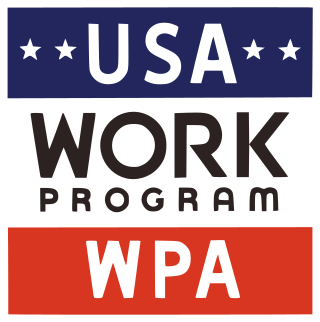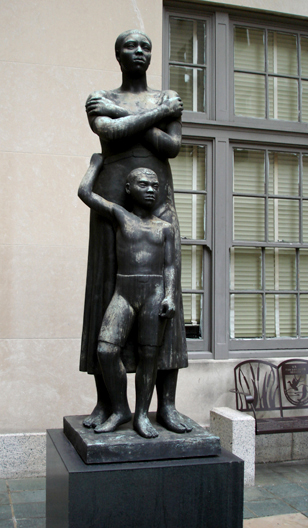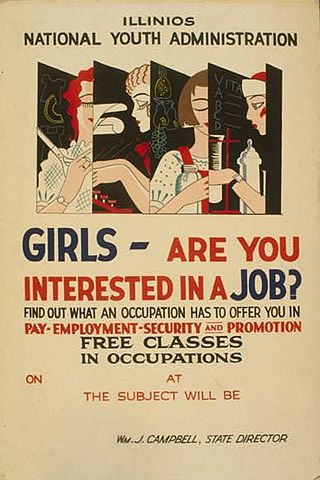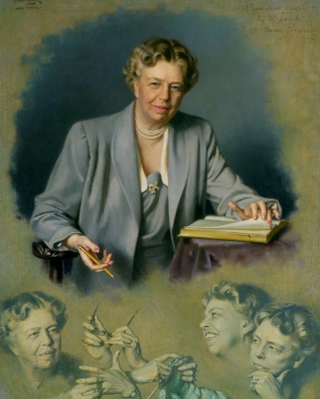
The Public Works Administration (PWA), part of the New Deal of 1933, was a large-scale public works construction agency in the United States headed by Secretary of the Interior Harold L. Ickes. It was created by the National Industrial Recovery Act in June 1933 in response to the Great Depression. It built large-scale public works such as dams, bridges, hospitals, and schools. Its goals were to spend $3.3 billion in the first year, and $6 billion in all, to supply employment, stabilize buying power, and help revive the economy. Most of the spending came in two waves, one in 1933–1935 and another in 1938. Originally called the Federal Emergency Administration of Public Works, it was renamed the Public Works Administration in 1935 and shut down in 1944.

The Works Progress Administration was an American New Deal agency that employed millions of jobseekers to carry out public works projects, including the construction of public buildings and roads. It was set up on May 6, 1935, by presidential order, as a key part of the Second New Deal.

Timberline Lodge is a mountain lodge on the south side of Mount Hood in Clackamas County, Oregon, about 60 miles (97 km) east of Portland. Constructed from 1936 to 1938 by the Works Progress Administration, it was built and furnished by local artisans during the Great Depression. Timberline Lodge was dedicated September 28, 1937, by President Franklin D. Roosevelt.

The Federal Writers' Project (FWP) was a federal government project in the United States created to provide jobs for out-of-work writers and to develop a history and overview of the United States, by state, cities and other jurisdictions. It was launched in 1935 during the Great Depression. It was part of the Works Progress Administration (WPA), a New Deal program. It was one of a group of New Deal arts programs known collectively as Federal Project Number One or Federal One.

The Federal Emergency Relief Administration (FERA) was a program established by President Franklin D. Roosevelt in 1933, building on the Herbert Hoover administration's Emergency Relief and Construction Act. It was replaced in 1935 by the Works Progress Administration (WPA).

The Historical Records Survey (HRS) was a project of the Works Progress Administration New Deal program in the United States. Originally part of the Federal Writers' Project, it was devoted to surveying and indexing historically significant records in state, county and local archives. The official mission statement was the "discovery, preservation, and listing of basic materials for research in the history of the United States". The creation of the Historical Records Survey was one of the signal events "in what Solon Buck called the 'archival awakening' of the 1930s".

The Federal Theatre Project was a theatre program established during the Great Depression as part of the New Deal to fund live artistic performances and entertainment programs in the United States. It was one of five Federal Project Number One projects sponsored by the Works Progress Administration, created not as a cultural activity but as a relief measure to employ artists, writers, directors, and theater workers. National director Hallie Flanagan shaped the FTP into a federation of regional theaters that created relevant art, encouraged experimentation in new forms and techniques, and made it possible for millions of Americans to see live theatre for the first time. Although The Federal Theatre project consumed only 0.5% of the allocated budget from the WPA and was widely considered a commercial and critical success, the project became a source of heated political contention. Congress responded to the project's racial integration and accusations of Communist infiltration and cancelled its funding effective June 30, 1939. One month before the project's end, drama critic Brooks Atkinson summarized: "Although the Federal Theatre is far from perfect, it has kept an average of ten thousand people employed on work that has helped to lift the dead weight from the lives of millions of Americans. It has been the best friend the theatre as an institution has ever had in this country."

The Federal Music Project (FMP) was a part of the New Deal program Federal Project Number One provided by the U.S. federal government which employed musicians, conductors and composers during the Great Depression. In addition to performing thousands of concerts, offering music classes, organizing the Composers Forum Laboratory, hosting music festivals and creating 34 new orchestras, employees of the FMP researched American traditional music and folk songs, a practice now called ethnomusicology. In the latter domain the Federal Music Project did notable studies on cowboy, Creole, and what was then termed Negro music. During the Great Depression, many people visited these symphonies to forget about the economic hardship of the time. In 1939, the FMP transitioned to the Works Progress Administration's Music Program, which along with many other WPA projects, was phased out in the midst of World War II.

The Federal Art Project (1935–1943) was a New Deal program to fund the visual arts in the United States. Under national director Holger Cahill, it was one of five Federal Project Number One projects sponsored by the Works Progress Administration (WPA), and the largest of the New Deal art projects. It was created not as a cultural activity, but as a relief measure to employ artists and artisans to create murals, easel paintings, sculpture, graphic art, posters, photography, theatre scenic design, and arts and crafts. The WPA Federal Art Project established more than 100 community art centers throughout the country, researched and documented American design, commissioned a significant body of public art without restriction to content or subject matter, and sustained some 10,000 artists and craft workers during the Great Depression. According to American Heritage, “Something like 400,000 easel paintings, murals, prints, posters, and renderings were produced by WPA artists during the eight years of the project’s existence, virtually free of government pressure to control subject matter, interpretation, or style.”

In his twelve years in office, United States President Franklin D. Roosevelt did not appoint or nominate a single African American to be either a secretary or undersecretary in his presidential cabinet. Denied such an outlet, African American federal employees in the executive branch began to meet informally in an unofficial Federal Council of Negro Affairs to try to influence federal policy on race issues. By mid-1935, there were 45 African Americans working in federal executive departments and New Deal agencies. Referred to as the Black Cabinet, Roosevelt did not officially recognize it as such, nor make appointments to it. First Lady Eleanor Roosevelt encouraged the group. Although many have ascribed the term to Mary McLeod Bethune, African American newspapers had earlier used it to describe key black advisors of Theodore Roosevelt, Taft, Harding, Coolidge, and Hoover.

The Public Works of Art Project (PWAP) was a New Deal work-relief program that employed professional artists to create sculptures, paintings, crafts and design for public buildings and parks during the Great Depression in the United States. The program operated from December 8, 1933, to May 20, 1934, administered by Edward Bruce under the United States Treasury Department, with funding from the Federal Emergency Relief Administration.

The National Youth Administration (NYA) was a New Deal agency sponsored by Franklin D. Roosevelt during his presidency. It focused on providing work and education for Americans between the ages of 16 and 25. It operated from June 26, 1935, to 1939 as part of the Works Progress Administration (WPA) and included a Division of Negro Affairs headed by Mary McLeod Bethune who worked at the agency from 1936 to 1943. Following the passage of the Reorganization Act of 1939, the NYA was transferred from the WPA to the Federal Security Agency. In 1942, the NYA was transferred to the War Manpower Commission (WMC). The NYA was discontinued in 1943.

The Relief Appropriation Act of 1935 was passed on April 8, 1935, as a part of Franklin Delano Roosevelt's New Deal. It was a large public works program that included the Works Progress Administration (WPA), the National Youth Administration, the Resettlement Administration, the Rural Electrification Administration, and other assistance programs. These programs were called the "second New Deal". The programs gave Americans work, for which the government would pay them. The goal was to help unemployment, pull the country out of the Great Depression, and prevent another depression in the future. This was the first and largest system of public-assistance relief programs in American history, and it led to the largest accumulation of national debt.

The Treasury Section of Painting and Sculpture was a New Deal art project established on October 16, 1934, and administered by the Procurement Division of the United States Department of the Treasury.

The American Guide Series includes books and pamphlets published from 1937 to 1941 under the auspices of the Federal Writers' Project (FWP), a Depression-era program that was part of the larger Works Progress Administration in the United States. The American Guide Series books were compiled by the FWP, but printed by individual states, and contained detailed histories of each of the then 48 states of the Union with descriptions of every major city and town. The series not only detailed the histories of the 48 states, but provided insight to their cultures as well. In total, the project employed over 6,000 writers. The format was uniform, comprising essays on the state's history and culture, descriptions of its major cities, automobile tours of important attractions, and a portfolio of photographs.

The New Deal was a series of programs, public work projects, financial reforms, and regulations enacted by President Franklin D. Roosevelt in the United States between 1933 and 1938. Major federal programs and agencies, including the Civilian Conservation Corps (CCC), the Works Progress Administration (WPA), the Civil Works Administration (CWA), the Farm Security Administration (FSA), the National Industrial Recovery Act of 1933 (NIRA) and the Social Security Administration (SSA), provided support for farmers, the unemployed, youth, and the elderly. The New Deal included new constraints and safeguards on the banking industry and efforts to re-inflate the economy after prices had fallen sharply. New Deal programs included both laws passed by Congress as well as presidential executive orders during the first term of the presidency of Franklin D. Roosevelt.

My Day was a newspaper column written by First Lady of the United States Eleanor Roosevelt (ER) six days a week from December 31, 1935, to September 26, 1962. In her column, Roosevelt discussed issues including civil rights, women's rights, and various current events. This column allowed ER to spread her ideas, thoughts, and perspectives on contemporary events to the American public through local newspapers. Through My Day, Roosevelt became the first First Lady to write a daily newspaper column. Roosevelt also wrote for Ladies Home Journal, McCall's, and published various articles in Vogue and other women's magazines.

The Wall Street crash of 1929 left many artists in the United States unemployed. Collectors who normally could afford to purchase such luxury items no longer had the means to do so. President Franklin D. Roosevelt's New Deal program created funding for art projects which would inspire confidence in American life and history. The program's objective was to hire artists to create works of art for display in public buildings throughout the country. From 1934 to 1943, there were various federally funded programs for artists in New Mexico – the Treasury Section of Painting and Sculpture, the Public Works of Art Project (PWAP), the Works Progress Administration (WPA)/Federal Art Project (WPA/FAP), and the Treasury Relief Art Project (TRAP).
Michael J. Gallagher born Scranton, PA 1898-died Philadelphia, PA 1965.

New Deal artwork is an umbrella term used to describe the creative output organized and funded by the Roosevelt administration's New Deal response to the Great Depression. This work produced between 1933 and 1942 ranges in content and form from Dorothea Lange's photographs for the Farm Security Administration to the Coit Tower murals to the library-etiquette posters from the Federal Art Project to the architecture of the Solomon Courthouse in Nashville, Tennessee. The New Deal sought to "democratize the arts" and is credited with creating a "great body of distinguished work and fostering a national aesthetic."



















